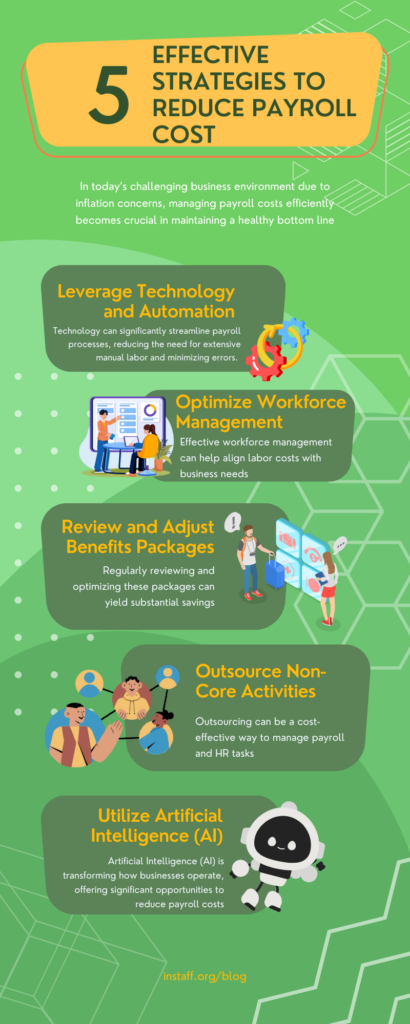
In today’s challenging business environment due to inflation concerns, managing payroll costs efficiently becomes crucial in maintaining a healthy bottom line. Here are five effective strategies to help reduce payroll costs:

Contents
1. Leverage Technology and Automation
Technology can significantly streamline payroll processes, reducing the need for extensive manual labor and minimizing errors. Here’s how you can leverage technology to reduce payroll costs:
- Payroll Software: Invest in reliable payroll software such as SAGE, that automates calculations, tax filings, and direct deposits. This reduces the time spent on administrative tasks and minimizes the risk of costly errors.
- Self-Service Portals: A centralized employee portal solution like InStaff will empower your employees to manage their own payroll information, such as updating personal details or accessing pay stubs. This reduces the administrative burden on HR staff.
- Time Tracking Tools: Implement digital time and attendance tracking solutions (such as InStaff) to ensure accurate and compliant recording of your employee’s work hours. This helps in preventing overpayment and reducing time.
2. Optimize Workforce Management
Effective workforce management can help align labor costs with business needs. Consider the following strategies:
- Flexible Work Arrangements: Offer flexible working hours or remote work options. This can reduce the need for physical office space and associated costs, while also potentially lowering salaries for remote positions based on geographic cost-of-living differences.
- Explore Offshore Talents: Hire offshore talents via a specialized agency like Hiva for roles that don’t require full-time or in-region staff. This can save your company up to 88% on payroll costs!
- Cross-Training Employees: Train employees to perform multiple roles within the company. This increases workforce flexibility and can reduce the need for additional hires during peak times or when employees are on leave.
3. Review and Adjust Benefits Packages
Employee benefits are a significant part of payroll costs. Regularly reviewing and optimizing these packages can yield substantial savings:
- Health Insurance Plans: Offer high-deductible health plans paired with Health Savings Accounts (HSAs) to reduce premium costs.
- Wellness Programs: Implement wellness programs to promote healthy lifestyles. Healthier employees typically have lower healthcare costs, which can lead to reduced premiums over time.
- Voluntary Benefits: Provide voluntary benefits such as dental, vision, or life insurance that employees can opt into and pay for themselves.
4. Outsource Non-Core Activities
Outsourcing can be a cost-effective way to manage payroll and HR tasks. Consider outsourcing the following:
- Payroll Processing: Outsource payroll processing to specialized firms that can handle it more efficiently and at a lower cost than in-house teams.
- HR Functions: Outsource HR functions like recruitment, training, and benefits administration to professional employer organizations (PEOs). This allows your business to benefit from their expertise and economies of scale.
5. Utilize Artificial Intelligence (AI)
Artificial Intelligence (AI) is transforming how businesses operate, offering significant opportunities to reduce payroll costs:
- Automated Scheduling: AI-powered scheduling tools can optimize employee shifts based on demand forecasts, availability, and labor laws. This minimizes overstaffing and understaffing, ensuring efficient use of labor.
- Chatbots for HR Queries: Deploy AI-driven chatbots with help from Azumo to handle common HR queries related to payroll, benefits, and time-off requests. This reduces the workload on HR staff, allowing them to focus on more strategic tasks.
- Predictive Analytics: Use AI to analyze historical data and predict future staffing needs. This helps in planning for peak periods and reduces reliance on costly last-minute hires or overtime.
- Payroll Audits: AI can conduct real-time audits of payroll data, identifying discrepancies and potential fraud. This ensures accuracy and compliance, reducing the risk of financial penalties.
Conclusion
Reducing payroll costs in 2024 requires a strategic approach that balances efficiency with employee satisfaction. By leveraging technology, optimizing workforce management, reviewing benefits, outsourcing non-core activities, and utilizing AI, businesses can achieve significant savings while maintaining a motivated and productive workforce.

